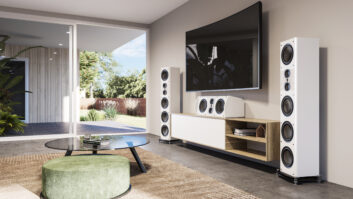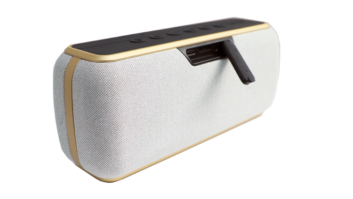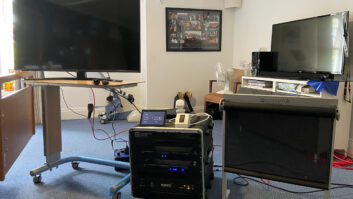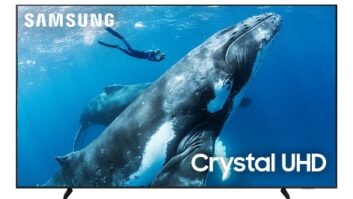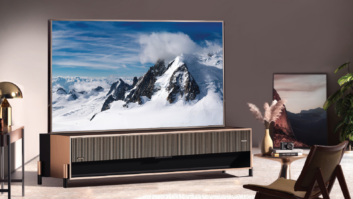While most “look at the year ahead” articles appear in January, or right after CES, we’ve decided to push the envelope a bit here by looking at the trends ahead as the first quarter of 2009 reaches its conclusion. No, that’s not cheating, for a number of things needed to settle into place before we could provide a decent view through crystal ball.
Indeed, one need look no further than last month’s issue of Residential Systems where we wrote about the state of the DTV transition even as its date was uncertain. In addition, rather than a traditional post-CES report littered with “this brand introduced this and that brand unveiled something else”, we’re going to try to keep this brand-free and concentrate on what to expect through the rest of the year, rather than from who. Now that most of the pieces are in place, a clearer view for the balance of the year is possible — at least until something else changes.
The DTV Transition: OK, Congress could change things yet one more time, but that is unlikely. The final transition date has been pushed back to June 12, but even with that said, it is a mixed bag as to whether or not a station will have already switched off their analog transmitter on the original February 17 date last month, if they will wait until the new sunset date, or if they will go digital-only somewhere in between. By now you should know the drill, as outlined last month, with the extra wrinkle that you for stations that are still on the air post February 17, you need to check with every station serving each of your clients to get their actual switch-over date. Then, re-scan, re-aim (antennae, as needed) and re-adjust. At 11:59:59:59 PM your local time on June 12 the “DTV Lady” will sing once and for all.
3-D Video: It would be easy to have come away from CES and other industry conferences and events in recent months thinking that 3-D for the home is just around the corner. Your clients have read the news reports, as well, and they might harbor the same thought. “Around the corner”? Well, not quite, unless the corner has a HUGE radius. There is a great deal still to be resolved, as the industry that seems as though it can’t get along without a standards battle is about to have another one or two.
There are about as many proposals for 3D technology out there now as there were HDTV system proposals back in the 1990s. Some will require new distribution systems, some won’t. Some are compatible with Blu ray (in that they can fit within its storage capacity) and some aren’t. Some would require an adaptor, but at least allow use with certain existing displays (predominantly DLP-based rear projectors); some would require significant enough changes to the display that current displays are now upward compatible to 3D. You get the picture — and for now it will not be one in 3D in the home.
Aside from the different technical approaches used, which in turn leads to different types of glasses being required, there are bandwidth issues. This is caused by the intersection of 3D and HD. Now that we’re all used to resolution up to 1080p, would you trade that for “540p per eye” if it brings you 3D? You can bet that behind the scenes there is a great deal of consumer acceptability, as well as technical research going on.
This all doesn’t mean that 3D isn’t going to happen. It will, and increasingly for theatrical motion picture releases, it already is. If anything, the increased production of 3D feature films means that the pressure will continue for an agreement on standards and that once everything is in place there will be libraries of 3D content to draw from. However, even when 3D is available in the home, exactly how much content will be available beyond movies is debatable. Still absorbing the cost of converting to digital transmission and HDTV, and facing declining ad revenues in a recessionary economic environment, networks, syndicators and local stations can’t be looking forward to spending money for a technology that they won’t be able to sufficiently monetize to cover the costs.
Think about it: Do you REALLY want to see the local news anchors, Jerry Springer, Judge Judy or a reality show in 3D? As a gimmick during sweeps, perhaps, but on a regular basis? Even though there is the feeling that sports programming, which has already seen 3D test broadcasts both in North America and Great Britain, would benefit from 3D, it will still take time for directors and camera crews to adjust to the new technology. To be kind, let’s leave it by saying that the combination of close-up shots, HD and 3D can, on occasion, be “nausea inducing”.
We’ll be covering the progress of 3D towards production, distribution and display standards throughout the year, but for now, while the work will continue on all fronts, standardized, widespread 3D is by most accounts at least 18 to 36 months off.
Rear Projection: This is an interesting one. On the surface, RPTV should be doing well. After all, at a time when money is tight for many consumers, RPTV still represents the best value from an “inches per dollar” standpoint once you get above 60-inch-wide screen sizes. Thanks to the high refresh speed possible with DLP, RPTV is one of the one display technology that is allows more present models to claim “3D compatibility.” With LED, laser and other advanced technology illumination systems it can not only get out from under the energy inefficiency of UHP light sources, but also thin down cabinet depths, as well.
That’s all well and good, but in an era when flat-panel displays dominate, it would appear that rear-projection television may be in danger of going the way of the CRTs that once provided the image engines for RPTV. Only one major manufacturer is now committed to new RPTV models, and despite their best efforts consumers seem to be voting elsewhere with their dollars. Is the promise of an easy transition to 3D and low cost enough to carry RPTV through to survival, if not a re-birth? Too hard to tell at this point, but don’t totally abandon it quite yet.
“Micro/Pico” Projectors: At the other end of the projection size spectrum comes another PTV form factor that is finally making a market entry. Some call them “Pico-Projectors”, others “Micro-Projectors”; we just call them amazingly small. In less than a year they’ve jumped from technology demonstration to fully commercialized products that are available from a number of brands. If you need to shoot a VGA-ish resolution image a short distance in reasonable room lighting and smallish size, these things are amazing.

The styling of this Dell micro projector resembles certain full size front projectors. Is there a place you can use it in your installations? Of course, the question is just exactly where will you need to do that? The next cut for these small wonders will be when they are built into cell phones and other wireless and portable devices, and there the applications are a bit more obvious. Where, however, will they fit in a residential environment? You’ll need to be creative here to find the right place for them, if any, but at least with the volume of brands and models now available, they are here if you need them. At the same time, a projector without a signal source is like that tree falling in the forest, except here no one will see, though the audio that needs to accompany the images is also important. How will the AV feed get to these units unless they are in a fixed installation?
For road warriors the ability to ask, “Is that a projector in your pocket or are you glad to see me?” is cool, but for residential use is the micro projector a solution in search of a problem. Only time, your clients’ needs and your skills will tell, but at leas the availability of the products, themselves, is no longer a gating item.
OLED: If this is the year that Micro-Projectors have their coming out party and RPTV may be making its farewell tour, OLED is stuck somewhere in the middle for large screen home entertainment applications. Sony’s 11″W display at $2,500 remains the only commercially available OLED screen beyond those used in portable or automotive applications. For the most part, the prototypes shown in a number of booths at CES were the same as last year, and the absence of any hard facts as to when (or perhaps if) any other OLED-based displays will be available.
Don’t read this as a foretelling of doom, but merely one of caution. There are significant benefits to OLED in terms of the incredibly thin screens and high contrast ratios made possible by an emissive technology, but the lack of even new or larger screens says that the engineering barriers to make this a practical, let alone affordable, technology are still significant. If you’re not careful, this is one where the publicity on the one set out there and its incredible picture and lure clients into saying they will waiting for something bigger rather than go with today’s technologies. This is one where if they propose that sort of wait, suggest that they have a copy of War & Peace or Ulysses to read while they wait; they will read through both of those lengthy tomes and more before large screen OLED is likely to be available.
Plasma vs. LCD: This isn’t quite a format battle in the traditional sense, as each of the two major flat panel display technologies has their place in the grand scheme of things. As with any product technology selection, don’t let a simple “this is better than that” statement make the decision, for the true choice should always be driven by the client’s specific application, room situation and budget first.
It is true that a number of brands have stepped back from plasma (PDP), and more recently one PDP’s most vocal proponents has announced that they will drop out of the display business altogether. Don’t read anything ill into that, as Pioneer’s decision was undoubtedly driven much more by business and economic realities than by anything having to do with technology.
Indeed, if you want a room-filling 103-inch flat-panel screen, PDP is the only option, and it is certainly the most affordable of the two large-screen technologies. On the other hand, if you need the absolute thinnest set out there, LCD is your answer.
There’s no clear “winner” here. Next year’s version of this article may see market shares for PDP vs. LCD change, but there is no doubt that both will be around to continue the “which is better” discussion.
Widgets and all things connected: Will 2009 be the “Year of the Widget”? Will this be the year when downloadable content really begins to make its mark? It is hard to tell, as the number of video displays with “widgets” or the capability to display other web-hosted content is still a small percentage of the total universe of displays sold. Still, the ability to show news updates, sports scores, weather or financial information on-screen without infringing on the main program image is increasingly being added to high-end sets as a means to differentiate them from less expensive commodity-drive products. Hmmm. Isn’t that the same part of the market where most of us trade?
At the same time, this will be the year when we’ll see more devices use network connectivity to enable viewing of web-based program content. Blu ray players that connect to movie streaming services, set-tops that both stream and store are here and we’ll see more of them. In addition, other home entertainment components that traditionally switched and processed incoming sources, but had little more than a tuner as their own internal sources will use direct connectivity to deliver internet radio and music streaming services, access to user-generated content sites such as YouTube, photo sharing services and social networking sites. Over time, though clearly not in the space of one, or even two years, it is not too much to say that this may change the profile of what consumer electronics products are all about.

Widgets and connectivity products will make viewing Internet-based content on a “main room display” easier, but will the concept click with consumers? What will this all mean? In the short term, it continues a trend that will sooner than later see virtually every product in the home entertainment system chain sport a network connection. While some of this will be accommodated by wireless or “no new wires” systems such as PLC or MoCA, the bandwidth all of this will require, particularly when there are simultaneous high-bandwidth demands on the system at the same time, the fickle finger of data will point back to what the residential installer does best: provide a hard-wired infrastructure. With four, if not eight-port switches being needed in many more rooms in the typical installation, the rise of widgets and connected players and products plays right to your strength. As manufacturers provide the “hook”, you get to provide the “line” — literally.
Go Green!: This is one of those all too rare instances where doing something that many believe is “good” is also good for business. As the economy tightens and concerns about global warming, high energy costs and resource shortages in the dews every day, going green will bring more green into your business.
Looking at products and technologies as we tend to do here shows one part of the picture, but it is only the tip of a greater trend. Now, more than ever, it isn’t just low-energy light fixtures and proper planning for their placement, it is using lighting control, environmental sensors and the entire palette of home automation systems not just as a way to control everything from a sexy touch-screen, but as a means of monitoring and cutting a home’s energy consumption. Particularly when dealing with retrofits aimed at increasing a home’s value to ready it for sale in an increasingly tight real estate market, this will give your clients something they can use as an edge over other homes in their area.

Low power consumption, as shown here at CES by Samsung for its new plasma models, will be an important trend going forward. Even the little things count. Help your clients and those within your own business adopt a “reduce/reuse/recycle” way of doing things that cuts energy consumption through little things such as a centralized place for device chargers that makes it easy to turn of these little energy consumers when no device is connected. Secure a relationship with a responsible recycler that can properly dispose of the old displays, computers and other electronics products you replace on the job and in the office in the normal course of business.
Of course, it goes without saying that as you evaluate products for any job, as you look at products and components look at both standby and in-use power consumption as part of system selection decisions. Then, look further into recycling the packaging, the recycled content of the unit, and any specific issues in disposing it at end of life. All of this will be particularly important if you become involved in certification programs such as LEED.

These modestly priced products from Kill-A-Watt give you an easy way to demonstrate power consumption to clients, particularly with energy-robbing wall-wart power adapters. No matter how you look at it, or why, all things “green” will be an important trend to deal with this year.
The “Lightning Round”: The trends above required a bit of explanation, but as they say in the world of game shows, in our “Lightning Round” you’ll find some one or two line “quickies” that we’ll cover in greater depth as the year moves on.
“120 is the new 60 and 240 is the new 120”: With 120Hz LCD sets becoming more commonplace, look for 240Hz to become the new high-end standard. As you look at 240Hz sets, keep in mind that there are a number of technology different approaches used to deliver it. As always, compare the results and select the brands that offer the picture and pricing that works best.
LED Illumination for LCD displays: This will be the new line of demarcation between commodity displays, for while the technology has many benefits; it is still expensive compared to conventional CCFL backlighting. Be aware of, and be able to explain the three ways it is implemented: white LED edge lighting, white LED backlighting with local dimming and RGB backlighting, also with local dimming. To a greater or lesser degree, a major benefit of LED illumination is the next trend:
Thin is In: It has been said that no one ever complained that their flat panel display was too thick, thin displays will be highly promoted to the high-end consumer. You won’t be able to escape it, so be prepared to know what to provision and when, along with the mounts that enable you to put these sets on the wall without making the total “off-the-wall” depth so thick that it destroys the benefit of the set, itself. And, don’t forget that thin displays are not solely the province of LCD, there are and will be very slim PDPs, as well.
Tru2way: This technology will ultimately replace the CableCard(tm) as a way to deliver scrambled and otherwise protected content to displays without the need for a set-top provided by the cable company. “Ultimately”, most likely. In any huge volume with widespread cable system availability? Not to any great degree this year. Sell this one in most cases as a “future proof” technology that will pay integration dividends down the road.
Femotcells: The use of a broadband connection to deliver improved in-residence cell phone connections through the creation of “micro-cells” is yet another integration challenge that you’ll see more call for as the year progresses.
HTiB moves upscale: Blu ray will increasingly be included in these all-in-one products to make them an interesting choice for “secondary room” placement throughout a residence.
Casual Gaming: Not every gamer is a hard-core player, and along with the trend to participatory games, console manufacturers, game developers and accessory suppliers will try to keep up the momentum in their industry by appealing to “once in while” players who simply want to play a game to blow off steam or get away from it all. Don’t limit game integration to larger rooms or where the “kids” are. Console games, along with their connectivity applications for media and content access will see much of their growth through casual users who might never have thought of themselves as “players”.
It’s an interesting array of technologies to watch, and we’ll help you with that as the year moves on. Don’t hesitate to keep count on how these trends develop. Let’s meet here at the end of the year and compare notes.
Michael Heiss ([email protected]) is a contributing editor for Residential Systems, based in Los Angeles.
